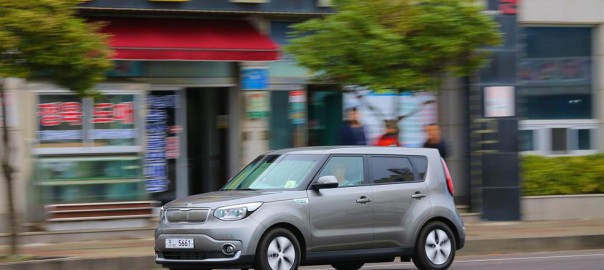Kia is set to launch its first electric car in the UK. The Soul EV looks great, but high-tech typically brings high prices. Can this stylish EV really ever add up?
[From November 2014] According to figures compiled by Kia, the fastest growing segment in the car market is electric vehicles, so it’s not surprising that the Korean giant has chosen to make it’s popular mini SUV, the Soul, available as an electric-only version. The Soul EV goes on sale in the UK before Christmas.
Far from simply ditching the conventional engines in favour of an electric motor and a battery, the Soul has undergone a fairly radical rethink in order to go zero-emission. With Kia also working on hybrid, plug-in hybrid and hydrogen technologies, it is fair to say that the firm is hedging its bets a little, but the Soul is its first attempt in the UK, at least, to push something that doesn’t run on petrol or diesel.
Kia is going to appoint a selection of its dealers to sell and service the EV, but it has modest sales expectations, with around 170 units a year expected to find homes. As a result, only one trim level and two colour schemes are available.
What’s the 2015 Kia Soul EV like to drive?
The standard Soul drives pretty neatly anyway, but it would reasonable to expect the extra weight of the batteries and electric motor to dull things dynamically. Oddly, that is not really the case. From behind the wheel, the Soul feels more than eager enough, as many electric cars do, thanks to instant availability of torque from rest. It can sprint to 60mph in around 11.5 seconds which is around a second slower than 1.6 diesel models, but the EV does so in virtual silence. The claimed range for the EV is 124 miles on a single charge and the top speed is 90mph, which mirrors the official figures of the Soul EV’s natural predator, the Nissan Leaf.
In order to take the additional weight of the batteries, the floor of the Soul has been beefed up with extra steel crossmembers, which has the effect of making it more rigid than the standard car. There’s also some 277kg of batteries beneath the floor, although if you are going to add weight anywhere, between the wheels and low down is not a bad place to do it. Aerodynamic improvements have also been made to make the EV slip through the air as cleanly as possible and this has reduced the wind noise at speed.
The effect of all this is that the Soul EV drives really very well. For town driving, there is a mode with extra regenerative braking to keep the batteries topped up, which allows one-pedal operation, where backing off the accelerator pedal essentially applies enough braking force. For most conditions, the standard drive mode requires less thought.
Refinement is usually a strong point of any electric car and so it is here. The ride is a touch firm, but is never uncomfortable, even over poor road surfaces.
What’s the 2015 Kia Soul EV like inside?
At a glance, the interior of the EV looks much like the standard Soul’s, but there are a few key differences. First up, Kia is keen to ensure that buyers know the EV is as green as it can manage, which means a lot of the interior materials are greener versions than those seen on the standard car. Items such as the dashboard panel, headlining and various plastic panels are made using bio- rather than petroleum-based plastics with a view to the car being more recyclable at the end of its life. It is nice place to be, though, regardless of what it is made out of.
There is only one interior finish available, and no options, because it’s already very well equipped with a large colour touch-screen infotainment and nav system. The cabin is finished in light grey with light blue piping; despite the floor being 80mm higher than in the standard car, to accommodate the batteries, the EV has reprofiled seats which ensure headroom is just as good as in the very roomy normal Soul. Both front and rear seats are comfortable and there’s plenty of room for four adults.
Boot space is also slightly reduced by the need to house all the electric paraphernalia under the floor, reducing the regular capacity by 30 litres, at 324 litres with the seats in place. All told, though, the boot is big enough for a car in this class and easily eclipses the BMW i3’s.
One thing that Kia is very proud of in the Soul is the hyper-efficient heating system. Typically, running the heater or air-conditioning in an electric car has a devastating effect on the range. Kia has developed two key technologies to mitigate this as much as possible. First is a setting which heats or cools only the occupied part of the cabin when there is one person on board. This means considerably less energy is expended and there is no detriment to the comfort of occupants.
The other clever development is that, rather than having an electric heating element to put a bit of warmth in the car on a cold morning, the Soul harvests warm air from around the car’s complex electronic systems, and from the ‘back end’ of the air-conditioning system, to ensure that no warm air is wasted when it might be put to good use. Kia reckons this system gives the car a significant advantage over rival cars, which lose considerable range in order to keep the cabin comfortable in hot or cold conditions.
Should I buy one?
Maybe.
Kia suggests the price is likely to be around £30k, with the government grant for plug-in cars dropping that to around £25k. That puts it at a slight disadvantage to the Nissan Leaf, which costs £23,590 after the grant when comparably equipped, and assuming you want to own the batteries – which is your only option with the Soul.
Nissan also offers the option of leasing the batteries for a monthly cost with the Leaf, which means you won’t be responsible for any maintenance, and also brings much lower initial purchase costs, with the top-spec Leaf Flex costing £18,590. Renault offers the an even cheaper rival to the Soul – the Zoe, which is smaller and can only be had if you lease the batteries from £70 per month, but will still seat four comfortably and be practical to live with, and costs from just £13,995.
Viewed in isolation, the Soul EV is a very appealing, technically clever and nice to drive electric vehicle but even with the government discount for plug-in cars, it is still likely to be too pricey for the majority to consider as a stylish second car. If you like the Soul, a petrol version in a comfortable trim level will be £10,000 cheaper, and that buys you a lot of petrol.
That said, if an electric car fits into your lifestyle, the Soul EV is a very likable, practical addition to the market and should be considered a genuine rival to the Nissan Leaf, Renault Zoe and even the BMW i3.
Source: What Car


